How to Phantom Ranch visit: Your Complete Guide to Exploring the Grand Canyon’s Hidden Retreat
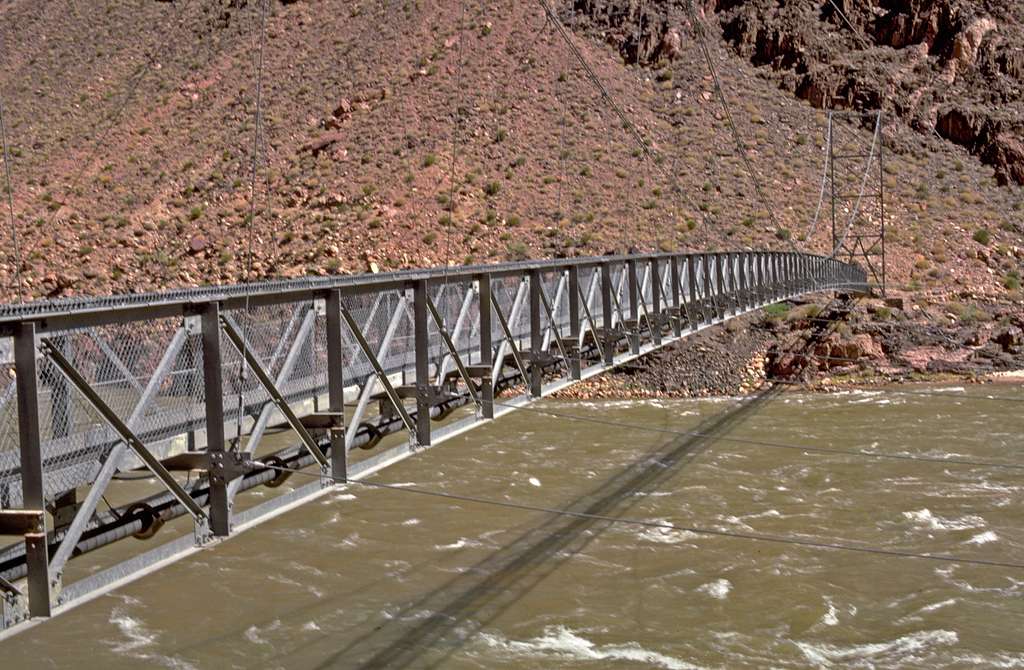
Phantom Ranch isn't just any place – it's the hidden gem nestled at the bottom of one of the world’s most iconic natural wonders: the Grand Canyon. Tucked away beside the Colorado River, Phantom Ranch is the only lodging within the depths of the canyon. It’s a place where time slows down, where the hustle of modern life is replaced by the echo of the wind, the sound of the river rushing past, and the crunch of your boots on dusty trails. What makes it truly extraordinary is not just its remote location, but the sense of accomplishment you feel when you arrive. You don’t just visit Phantom Ranch – you earn it.
The journey to Phantom Ranch is as much a part of the experience as the destination itself. Whether you’re hiking down the steep trails or taking a mule ride along the canyon’s rocky ledges, the adventure begins long before you reach the cool shade of the ranch’s cottonwood trees. There’s no drive-up access, no casual strolling in. You’ve got to work for it, but the reward is worth every step.
How to Get to Phantom Ranch: Hiking Routes
Bright Angel Trail: The Classic, Scenic Route
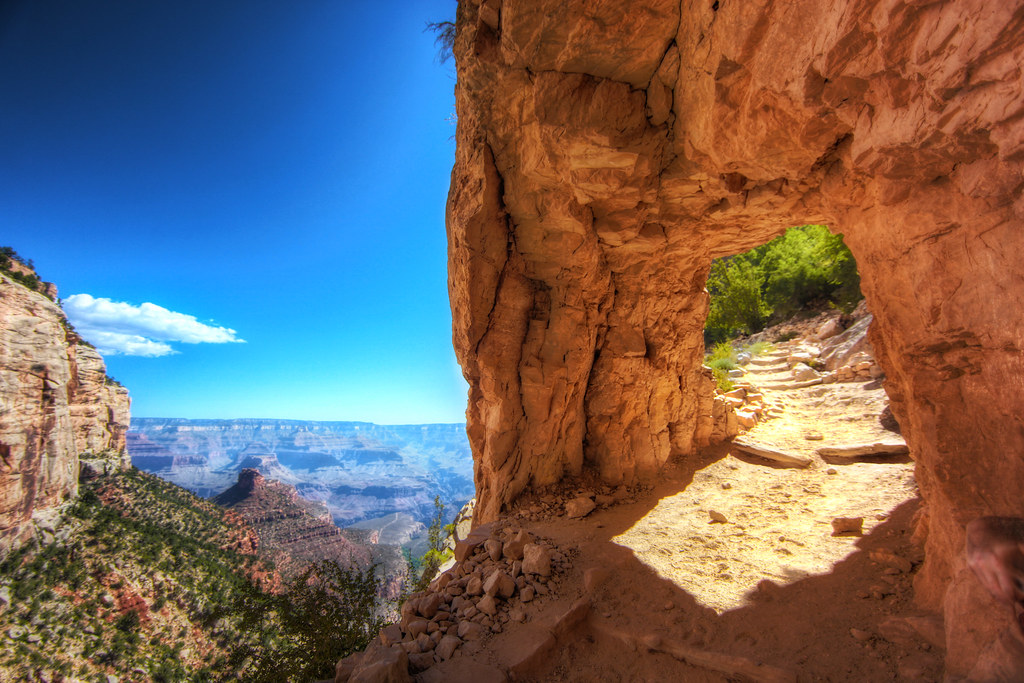
The Bright Angel Trail is the most popular route to Phantom Ranch, and for good reason—it offers a mix of challenging hiking, beautiful scenery, and relative accessibility for those prepared for the journey. Starting from the South Rim, you’ll be diving deep into one of the most iconic landscapes in the world.
Distance and Elevation
The full hike to Phantom Ranch via Bright Angel Trail is about 9.5 miles one way, with an elevation change of 4,380 feet. You’ll be descending the full depth of the Grand Canyon—trust me, that’s no joke, but every step rewards you with mind-blowing views.
The descent feels pretty doable, but don’t be fooled. Going down is always the easy part—hikers often underestimate the energy they’ll need for the return climb. If you’re thinking of doing this hike as a day trip, be cautious. The average time to hike down is around 4 to 6 hours, but that entirely depends on your pace and how often you stop to take in the views (which will be hard to resist). Coming back up? That’s a different story. Allow 6 to 8 hours to climb back up to the South Rim.
What to Expect on the Trail
The trailhead starts at Bright Angel Lodge, and right from the get-go, you’ll be treated to sweeping views of the canyon. The first few miles are steep but well-maintained, with switchbacks to help manage the descent. Along the way, you’ll pass rest stops like 1.5 Mile Resthouse and 3 Mile Resthouse, which offer shaded areas, water (during the warmer months), and a place to take a breather. Make sure you’re hydrating constantly.
About halfway down, you’ll hit Indian Garden, an oasis in the desert, complete with cottonwood trees, a bubbling creek, and—best of all—restrooms and water. This is the last reliable water source before you hit the bottom, so fill up. The scenery around Indian Garden is a stark contrast to the rocky, exposed terrain you’ve been hiking through. From here, you’ve still got about 4.5 miles to go.
As you continue downward, you’ll start to hear the rushing of the Colorado River before you see it. By the time you cross the Silver Bridge, you’re just minutes away from Phantom Ranch. The river’s deep green water cutting through the red rock is pure magic.
Difficulty
Bright Angel is tough, but it’s well-trafficked and has more gradual elevation change than the South Kaibab Trail. With its resthouses and more frequent shade, this trail is a bit more forgiving. However, don’t let that lull you into thinking it’s easy. You’ll need to be in solid shape, carrying plenty of water and snacks, and prepared for extreme weather conditions, especially in summer. The return hike is notorious for being brutal, with the ascent feeling twice as hard as the descent.
South Kaibab Trail: Shorter, Steeper, and Wild
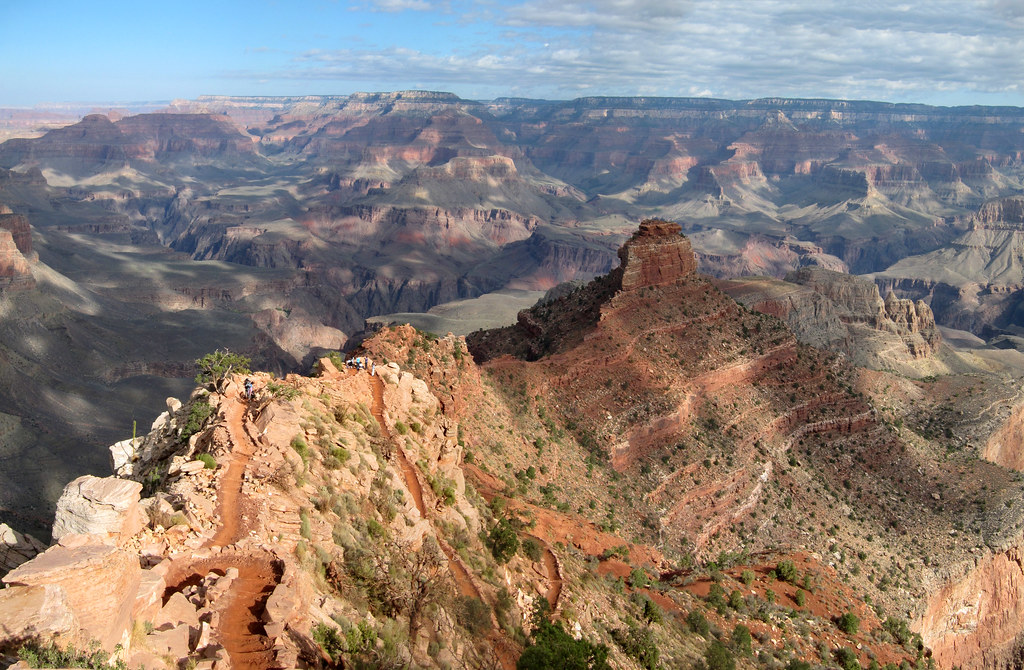
For hikers looking for a quicker, steeper route, the South Kaibab Trail is a fantastic option—but be warned, it’s not for the faint of heart. Starting from Yaki Point, this trail is more direct, cutting straight down the canyon with little mercy on your knees or quads.
Distance and Elevation
The South Kaibab Trail is 7.1 miles to Phantom Ranch, with an elevation change of about 4,780 feet. It’s shorter than Bright Angel, but what you save in distance, you gain in intensity. This trail is steeper, with fewer switchbacks to help ease the descent, and it’s almost entirely exposed to the elements.
Time to hike down is usually between 4 to 5 hours, but expect to spend 6 to 8 hours if you’re coming back up. Most people recommend using Bright Angel for the ascent due to its more gradual incline and the water stops along the way.
What to Expect on the Trail
The first thing to know about South Kaibab: it’s exposed—no water, no shade, just you and the canyon. That makes this trail a better choice in the cooler months or for those starting super early in the day.
Despite the exposure, the views are nothing short of jaw-dropping. You’ll feel like you’re walking along the spine of the canyon, with expansive vistas opening up in front of you at every turn. The Ooh Aah Point (yes, that’s its actual name) hits early in the hike, about 1 mile down, and trust me, it’s named perfectly. The sheer beauty will stop you in your tracks.
Further down, you’ll pass Cedar Ridge and Skeleton Point, both offering unbeatable viewpoints of the canyon and the river below. While these lookouts are stunning, the trail’s lack of water and shade means you have to keep moving steadily. Don’t plan on stopping for long—you don’t want the sun to catch up to you.
Once you hit the bottom, you’ll cross the Black Bridge over the Colorado River and follow the riverbank to Phantom Ranch. Despite its shorter distance, the steepness and exposure make South Kaibab more challenging than Bright Angel, so plan accordingly.
Difficulty
South Kaibab is a tougher, more rugged experience. While Bright Angel feels like a winding journey, South Kaibab is a straight shot down into the heart of the canyon. This is a trail for strong hikers who are well-prepared and up for the challenge. Pro tip: most hikers opt to descend via South Kaibab and return via Bright Angel to save their legs from the grueling climb out.
Mule Rides to Phantom Ranch
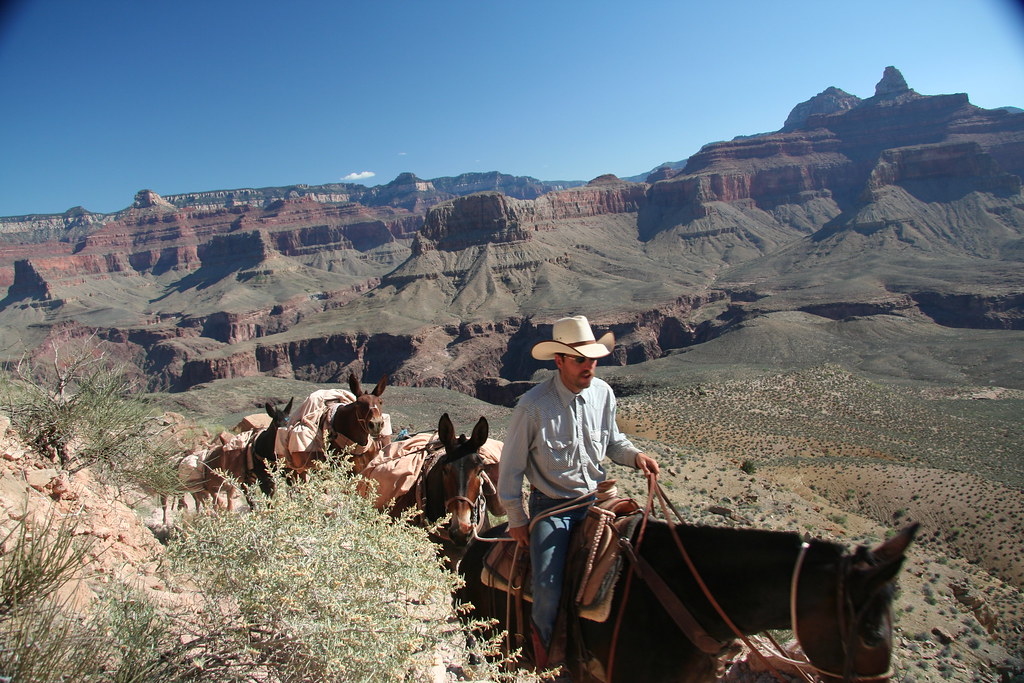
Alright, hikers—let’s talk about the ultimate cheat code for reaching Phantom Ranch: mule rides. Whether you’re not up for the intense hike or simply want to experience the Grand Canyon in a more laid-back (but totally epic) way, this is your go-to option. It's not just a ride—it's a journey through time, traversing the same paths that have been used for over a century. And yes, these sturdy mules are like the true desert SUVs—steady, reliable, and more surefooted than you’d ever expect.
Booking Your Mule Ride: The Insider's Scoop
Now, getting a mule ride isn’t as simple as showing up and hopping on one of these four-legged heroes. You’ve got to plan ahead—way ahead. Here’s how you nail it:
- How to Book: The mule rides are operated by Xanterra Parks & Resorts, and you’ll need to make a reservation well in advance—sometimes even a year out, especially if you're aiming for peak seasons like spring or fall. You can book directly through their website or by calling the Grand Canyon mule ride reservation office.
- Age, Weight, and Height Restrictions: To ensure safety, there are a few restrictions. Riders need to weigh less than 200 pounds (fully dressed) and be at least 4 feet 9 inches tall. Sorry, kids under 10, but you’ll have to wait a bit to ride these majestic creatures.
- What’s Included: The mule ride packages typically come with overnight accommodations at Phantom Ranch (yes, you get to stay in one of those rustic, cozy cabins) and a hearty meal (you’re going to need it after the ride). You’ll also get water refills, saddle bags for your gear, and the guarantee of an unforgettable experience.
The Ride: What to Expect
Okay, so what does a day on the back of a mule look like?
- Duration: The ride from the South Rim to Phantom Ranch typically takes about 5 hours, winding down along the Bright Angel Trail. Trust me, it's not just about getting from point A to point B; it's a surreal experience. You'll witness the canyon walls shift and change color as the light hits them, feel the crisp air, and absorb the staggering beauty of the Colorado River far below.
- The Experience: Unlike hiking, you get to sit back and let the mule do all the work. The mules are incredibly sure-footed, navigating the narrow trails and steep switchbacks like pros, which means you can relax and take in the views. And yes, the guides will be cracking jokes and sharing canyon lore the whole way down.
- Overnight at Phantom Ranch: Once you reach the bottom, you’ll be treated to a hot meal and a warm bed. Whether you're staying in a cabin or the dormitory, it's a welcome relief after your ride. If you’re lucky, you might even have time to explore a bit before tucking in for the night. The next morning, you’ll saddle up for the return trip—a story you’ll be telling for years.
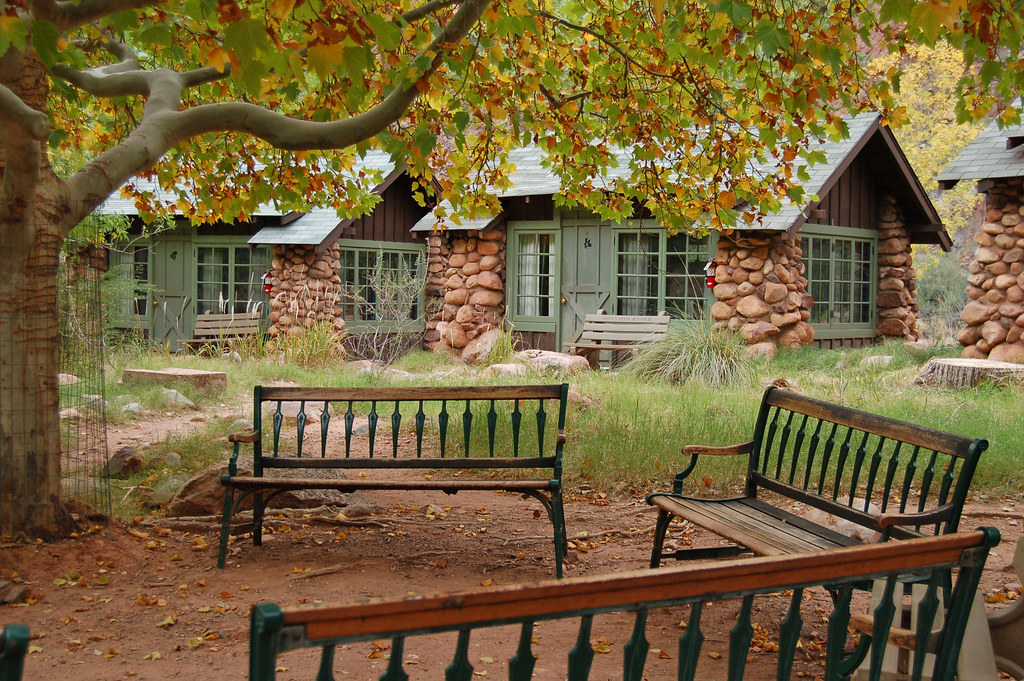
Permits, Reservations, and Availability Phantom Ranch
Securing a stay at Phantom Ranch is no easy feat. With limited spots and high demand, the reservation process can feel like a race against time. But don’t worry—I’ve got you covered. For a detailed step-by-step guide on how to successfully book your stay, including tips on availability and what to expect, check out my complete post on How to Get a Reservation at Phantom Ranch in 2024
Costs and Pricing for Phantom Ranch
You’re heading to the bottom of the Grand Canyon, a place few get to sleep under the stars in comfort. But before you lace up your boots and head down that trail, you need to know exactly how much this once-in-a-lifetime experience will cost. Let's break it all down—because when you're this far from civilization, it's good to know what you're paying for.
Cabins at Phantom Ranch: Your Cozy Hideaway
Imagine this: after a long, challenging hike, you settle into a rustic cabin nestled deep in the canyon. It’s not luxurious, but it’s comfortable, and after a day on the trail, it feels like five-star accommodations. These cabins come with a few essentials to make your stay easier.
- Cost: Staying in a private cabin costs around $200–$300 per night, depending on the season. Yes, it’s a bit steep, but consider that it includes your bedding, linens, and even air conditioning—a blessing in the canyon’s summer heat.
- What’s Included: Besides the cozy bed and climate control, you’ll have a private bathroom (though showers may be in shared spaces). It’s like your own little retreat after braving the canyon. Just know you’ll be sharing it with friends like the occasional canyon critter—part of the charm!
Dormitories: Budget-Friendly and Social
Not feeling the private cabin? Dormitories are your other option, and they come with the added bonus of meeting fellow adventurers. These aren’t hostel-style, though—think more along the lines of sleepover camp, but for rugged hikers.
- Cost: Dorms are much more affordable at $65–$75 per person, per night. You’ll be sleeping in a bunk bed, but hey, after that trek, you’ll sleep like a log regardless.
- What’s Included: You get a bunk, clean bedding, and access to shared restrooms. It’s not fancy, but it’s perfect for those who don’t mind communal living. There’s separate housing for men and women, so it’s a good option if you’re traveling solo and want to save some cash.
Meal Packages: Feed the Beast (That’s You)
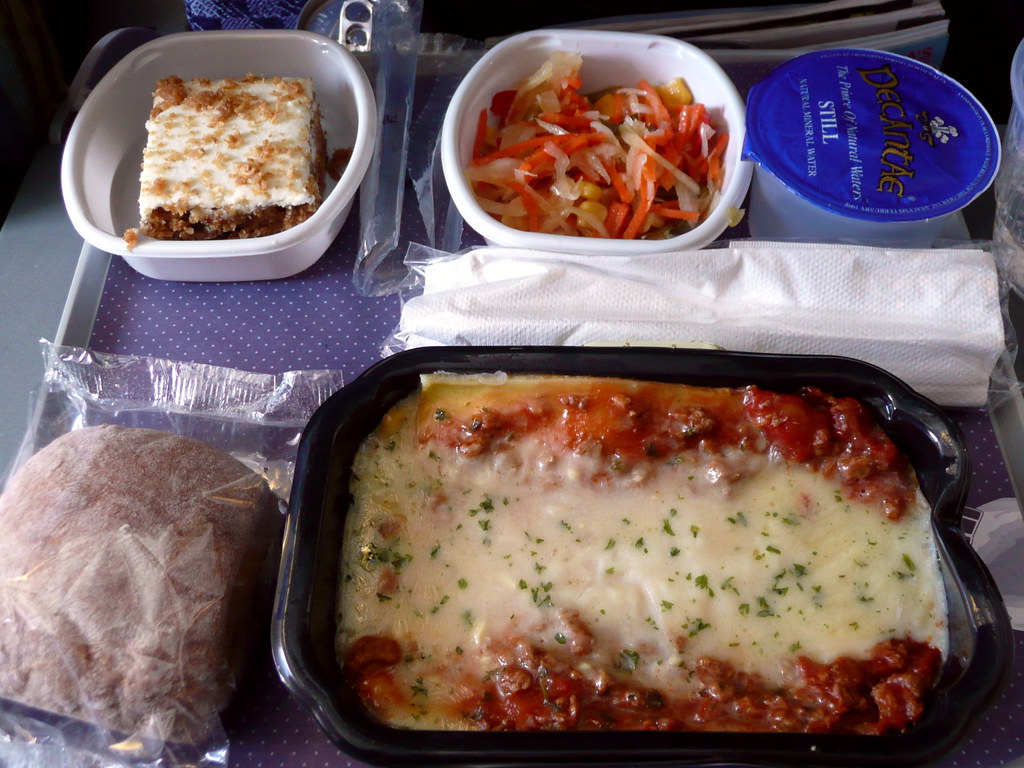
After hiking the Grand Canyon, food stops being just food—it’s fuel, it’s reward, and it’s downright necessary. Phantom Ranch has meal packages you’ll want to book in advance because meals here are like golden tickets—you don’t want to miss out.
- Breakfast: At around $25 per person, breakfast is an early affair but well worth it. Picture a hearty spread—eggs, bacon, pancakes, and coffee that tastes like pure energy. Perfect to start another day of adventure.
- Lunch: If you’re sticking around or need a packed lunch for the trail, it’s about $20. It’s simple, but enough to get you through until dinner.
- Dinner: The highlight. A steak dinner (yes, steak at the bottom of the Grand Canyon!) will set you back $60. Don’t eat meat? No worries. The vegetarian stew option is a bit cheaper at $50, and it’s just as filling and delicious. The meals are large, because let’s face it—you’ve earned it.
Pro Tip: All meals must be reserved ahead of time when you book your stay, so plan your budget accordingly!
Additional Costs: The Extras That Add Up
Planning to splurge a little more on this trip? Here are a few extra costs to keep in mind:
- Mule Ride Fees: Not up for hiking? A mule ride down to Phantom Ranch runs around $600–$700 round trip. This includes your accommodation and meals—so it’s kind of like a package deal. Plus, you get to sit back and let the mule do the work.
- Rafting Package Fees: Rafting trips that include a stop at Phantom Ranch can be booked through third-party operators, and these can vary widely in price, but expect to pay at least $2,000–$4,000 for multi-day trips. You’ll get meals and gear included, along with an unforgettable experience on the Colorado River.
- Canteen Souvenirs and Snacks: You’ll likely want to pick up a memento from the Phantom Ranch Canteen, but be prepared—prices for snacks and drinks reflect their remote location. Factor in a little extra cash for souvenirs, postcards, or an emergency Snickers.
Accommodation and Amenities at Phantom Ranch
Lodging Options: Cabins vs. Dorms
So, you’ve managed to score a reservation at Phantom Ranch congrats! But now you’re wondering, “What am I actually getting for my money?” Let’s break it down:
- Cabins: If privacy is your jam, cabins are the way to go. These rustic but cozy spots have a private bathroom (yes, you read that right—a private bathroom in the middle of the Grand Canyon!). Each cabin comes with heating in winter and AC in summer, so no need to worry about the extreme temps. The setup is basic but comfortable, with beds, linens, and towels all provided. And don’t forget, they clean up daily—so you get a little slice of luxury after a hard day’s hike.
- Dorms: If you’re flying solo or just cool with making some trail friends, the dormitories are a more budget-friendly option. Here’s how it works: the dorms are split by gender, each holding 10 people. It’s bunk beds all the way, with shared bathrooms (communal living, anyone?). You’ll still get linens, a towel, and a bit of that Phantom Ranch magic—but expect less privacy and a bit more camaraderie. If you’re snoring, at least you’ll blend into the nighttime canyon sounds, right?
Facilities: Restrooms, Showers, and Laundry
It’s the Grand Canyon, not a five-star hotel, but Phantom Ranch does a surprisingly good job of keeping things clean and functional.
- Restrooms: Both the cabins and dorms have restrooms. If you’re in a cabin, lucky you—it’s private. For dorm dwellers, the restrooms are shared but well-maintained. Expect basic, no-frills facilities, but hey, after a long hike, flushing toilets will feel like a luxury.
- Showers: Here’s where things get interesting. You can take a shower, but only if you’ve booked a bed. No sneaking in after your hike to freshen up before heading back out—showers are reserved for overnight guests only. The water’s hot, though, so it’s perfect after a day on the trails. Cabins have private showers, while dorms have shared ones. Either way, trust me, that first rinse-off is gonna feel like heaven.
- Laundry: Phantom Ranch doesn’t offer laundry facilities for guests, so plan ahead. This isn’t the place to be scrubbing your socks in the sink—best pack light and smart. Quick-dry fabrics and minimal changes of clothes are the way to go. Besides, after a few days in the canyon, everyone’s rocking that dusty, trail-worn look.
The Dining Hall: A Communal Oasis
The Phantom Ranch Dining Hall is more than a place to refuel—it’s where stories from the day’s hike get swapped, new friendships are forged, and, let’s be real, you stuff your face because you’ve earned it.
- Meals: Meals here are an experience. Breakfast is hearty—think pancakes, eggs, bacon, the works. Dinner? You’ve got two options: steak or vegetarian stew, and both are as comforting as a campfire story after sunset. The meals are served family-style, so prepare for some elbow-rubbing with fellow adventurers. You’ll sit down, eat with whoever is around, and by the end of it, you might have new hiking buddies for the trek back up. Coffee and iced tea are on tap to keep you going—hydration and caffeine are your best friends down here.
- Meal Plans: You’ll need to book your meals in advance. Seriously, no last-minute drop-ins for dinner because they plan it all out. If you’re staying, make sure you lock in those meals when you book your bed.
Phantom Ranch Canteen: Snacks, Souvenirs, and Survival Essentials
Now, let’s talk about the Phantom Ranch Canteen. It’s small, but it’s the lifeline you didn’t know you needed after a long hike. Got a craving for a cold lemonade or an ice-cold beer? They’ve got you covered. It’s like a mini-miracle at the bottom of the canyon.
- Snacks: You can grab a quick bite like trail mix, energy bars, or even some candy. Perfect for those post-hike munchies or for stashing away in your pack for the return trek.
- Souvenirs: Need proof that you made it? The canteen’s got some great souvenirs—think t-shirts, mugs, and even those coveted Phantom Ranch postcards. Mail a card right from the bottom of the Grand Canyon and get an official Phantom Ranch postmark—talk about bragging rights!
- Other Supplies: Forgot something? The canteen stocks a few basics like sunscreen, lip balm, and moleskin (because blisters are real, folks). They even sell small first-aid items and emergency supplies. It’s not a full-on grocery store, but it’ll get you by in a pinch.
Activities and Experiences at Phantom Ranch
Hiking and Exploring Near Phantom Ranch: River Trail & Plateau Point
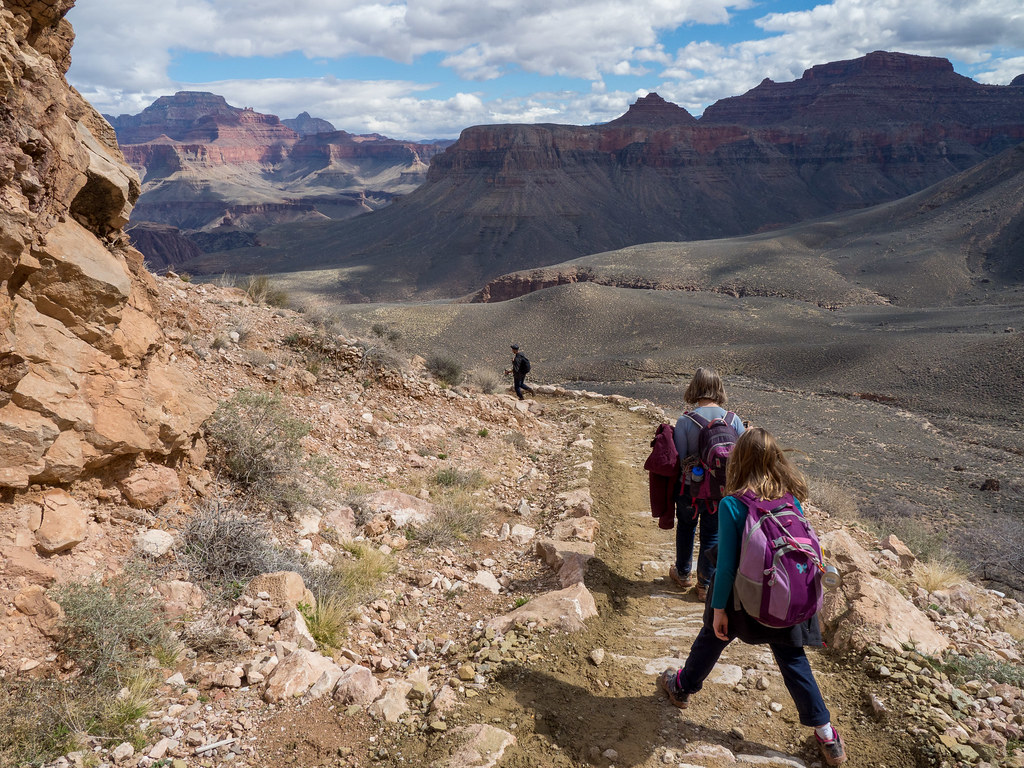
Once you’ve conquered the epic descent into Phantom Ranch, your adventure is far from over. Now you’re in the heart of the Grand Canyon, and some shorter hikes are just begging to be explored. Let’s start with two you can’t miss:
The River Trail – Imagine taking a leisurely stroll right next to the mighty Colorado River. This trail is a short, relatively flat path that runs along the riverbank and gives you a chance to soak in the canyon’s rugged beauty without the heavy elevation gains of your previous trek. As you walk, the cool breeze from the river keeps you refreshed, and the sound of the rushing water brings a sense of calm after the intensity of your descent. It’s about a mile long, making it the perfect warm-up or cool-down hike.
Plateau Point – Now, this one is for those craving a jaw-dropping view. If you’ve got some energy left, tackle the 6-mile round-trip hike from Phantom Ranch to Plateau Point. The trail itself is a steady climb, but it’s absolutely worth it. When you arrive at Plateau Point, you’re rewarded with one of the most iconic overlooks in the canyon. You’ll be standing right above the Colorado River, staring into the depths of the Grand Canyon like you own the place. The vibrant colors of the rock layers are otherworldly, and the view is completely unobstructed. Pack plenty of water and snacks because the sun can be relentless up here.
Ranger Programs: Learning in the Canyon’s Classroom
Phantom Ranch isn’t just a place to rest your legs—it’s a hub of learning and discovery, thanks to the ranger-led programs that are sometimes offered. Picture this: you’re gathered with a small group of fellow hikers as a park ranger, someone who lives and breathes the Grand Canyon, shares stories about the canyon’s history, geology, and the ancient peoples who once called this place home. These programs often take place in the evening, under the stars, where the vastness of the canyon takes on an entirely new mystique. It’s a moment of reflection where you get to connect not just with the landscape but with the rich cultural and natural history that has shaped it.
Be sure to check the bulletin board at Phantom Ranch for any scheduled programs—trust me, these talks are a brilliant way to unwind and soak up knowledge that makes the Grand Canyon experience even more profound.
Wildlife and Nature: The Canyon’s Wild Residents
Now, let’s talk wildlife, because Phantom Ranch is surrounded by critters you won’t see every day. As you hike or rest, keep your eyes peeled for the canyon’s most famous residents—the bighorn sheep. These nimble creatures navigate the steepest cliffs like it’s a casual walk in the park. You might spot them high up on the cliffs, or if you’re lucky, you’ll get an up-close look at one as it grazes nearby.
Then, there are the California condors, with wingspans stretching up to 10 feet. These rare, majestic birds can often be seen soaring overhead, casting enormous shadows against the canyon walls. And don’t forget the smaller residents: desert lizards dart across the trails, and if you’re an early riser, you might catch a glimpse of mule deer grazing near the riverbanks. Each sighting reminds you that this place is teeming with life, even in its ruggedness.
Flora in the canyon also deserves attention. Down at Phantom Ranch, you’re in a completely different ecosystem from the rim. You’ll find lush greenery around the creek and hardy desert plants like agave and yucca thriving in the arid environment. The juxtaposition of vibrant plant life against the stark canyon walls is pure magic.
Stargazing: The Grand Canyon’s Nighttime Spectacle
When night falls, the adventure takes on an entirely new dimension. Thanks to the ranch’s remote location, the skies here are some of the darkest in the country, making it a stargazer’s paradise. As the sun dips below the canyon walls and the last light fades, the Milky Way emerges in full force, stretching across the sky like a ribbon of diamonds.
There’s something deeply humbling about lying on your back, looking up at thousands of stars twinkling overhead, while the canyon cradles you in its massive embrace. No light pollution, no distractions—just you, the stars, and the whisper of the river in the distance. It’s a cosmic reminder of how small we are in the grand scheme of things and how special this place truly is. Whether you're an astronomy buff or just someone who loves a good night sky, bring a blanket, find a quiet spot, and let the stars steal the show.
And trust me, this is one of those moments where no camera will do it justice you just have to experience it.
Best Time to Visit Phantom Ranch
Spring and Fall
Ah, spring and fall — the magic seasons where everything aligns perfectly for your trek to Phantom Ranch. Imagine waking up to crisp canyon air, the sun warming your back as you descend into the gorge, and no heat waves knocking you off your game.
Why It’s the Best Time:
- Perfect Hiking Weather: Temperatures hover between a delightful 50°F to 80°F, especially in March to May and September to November. You won’t need to worry about heat exhaustion or frozen toes — just good old-fashioned hiking. Daytime highs are manageable, and nights are cozy cool.
- Scenic Beauty: Spring brings the canyon to life with vibrant wildflowers and flowing creeks, while fall offers golden hues, as if the entire Grand Canyon dressed up just for you.
- Easier Trail Conditions: The trails are dry, and the risk of flash floods is low, making it a hiker’s paradise. In spring, the Colorado River might be a little more lively due to snowmelt, adding to the scenery without complicating the hike.
Crowds: Here’s the catch — everyone loves this time. Reservations are tight, and spots at Phantom Ranch can vanish in the blink of an eye. You need to book at least 13 months ahead, so get your calendar out, start counting backward, and claim your spot!
Summer
Summer at Phantom Ranch is no joke. You’re not just hiking — you’re entering a furnace where temperatures can soar beyond 110°F at the bottom of the canyon. The sun is your constant companion, whether you like it or not, and your survival kit better include gallons of water.
Why You Might Go Anyway:
- Bragging Rights: Not everyone can say they survived a hike through the Grand Canyon in the middle of July. If you love pushing boundaries and laughing in the face of dehydration, summer’s your time.
- Early Mornings or Late Afternoons: Hikers that make it through the summer usually hit the trails at the crack of dawn (we’re talking 4 a.m.) or wait until late afternoon when the sun starts chilling out. Midday is a no-go unless you fancy a heat stroke.
Survival Tips:
- Hydrate Like a Camel: Bring more water than you think you need. Seriously, double it. Dehydration here isn’t just uncomfortable; it’s dangerous.
- Pack Electrolytes: Water alone won’t save you. Pack salt tablets or electrolyte drinks to replace what you sweat out.
Crowds: Surprisingly, summer is less crowded. Fewer people want to brave the heat, so if you’re after some solitude and are willing to suffer for it, you might have more elbow room on the trail. But be warned, the accommodation situation remains competitive because the Ranch itself has limited availability all year round.
Winter
Winter offers two vastly different experiences — mild and manageable at the canyon floor, but potentially icy and snow-covered at the rim. Hiking in the winter is a bit of a gamble, but if you’re a fan of cooler temps and don’t mind the cold, it’s a whole new kind of adventure.
What You’re in For:
- Rim Snow, Canyon Warmth: Snow often blankets the South Rim, which can make the beginning and end of your hike slippery and slower. At the bottom, though? It’s much more pleasant, with daytime temperatures hovering around 40°F to 60°F.
- Shorter Days: The sun sets earlier in winter, so you’ll want to start your hike early to avoid getting caught in the dark. There’s something pretty spectacular about watching the sun dip behind the canyon walls, but not when you’re still miles away from Phantom Ranch.
Challenges:
- Icy Trails: Be ready for icy patches on the higher elevations of the trail, especially early in the morning or late in the day. Microspikes or crampons can be your best friend here.
Crowds: Winter sees fewer hikers. If you want a quieter experience and don’t mind bundling up at the rim, this is the time to go. The Ranch isn’t overrun, but it’s still recommended to book ahead since space is always limited.
Crowds and Availability
Phantom Ranch is small — and everyone wants a piece of it. Whether you're hiking in the glorious spring or braving the summer sun, accommodations are limited to 90 guests (that’s dormitories and cabins combined). No matter the season, you’re competing with hikers, mule riders, and river rafters for a bed.
- Spring and Fall: Fully booked — often over a year in advance. No kidding, the minute reservations open, they’re gone. Put your planning hat on and be relentless.
- Summer: You’ll have a better chance, but you’ll also face the unforgiving heat. There might be more last-minute openings due to cancellations, so it’s worth checking.
- Winter: Similar to summer, there’s slightly more availability, but it’s not guaranteed. Cancellations due to weather can free up spots, but again — be prepared for those tricky conditions.
Conclusion
Phantom Ranch is more than just a stop along the Grand Canyon—it’s an unforgettable journey that rewards adventurers with its remote beauty and unique experiences. Whether you arrive on foot via the challenging Bright Angel or South Kaibab Trails, or by mule ride, reaching the ranch is an accomplishment that blends rugged adventure with peaceful serenity. The cozy cabins and dorms, hearty meals, and the camaraderie of fellow travelers make the stay both comfortable and communal. As you explore the canyon’s hidden wonders, from hiking to stargazing, you’ll find Phantom Ranch to be a true gem, offering an experience like no other in one of the world’s most iconic landscapes.
Hello! I’m,Ratndip a dedicated trekking enthusiast with a deep love for exploring the world’s most captivating trails. With over 2 years of trekking experience, I’ve had the privilege of hiking through stunning landscapes, from the majestic Himalayas to the lush Amazon rainforest. My journey into trekking started as a personal quest for adventure and has evolved into a lifelong passion for discovering new terrains and connecting with nature.